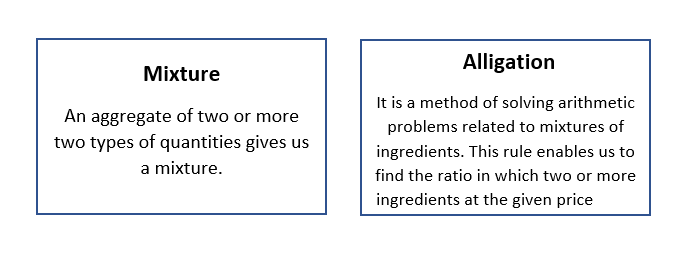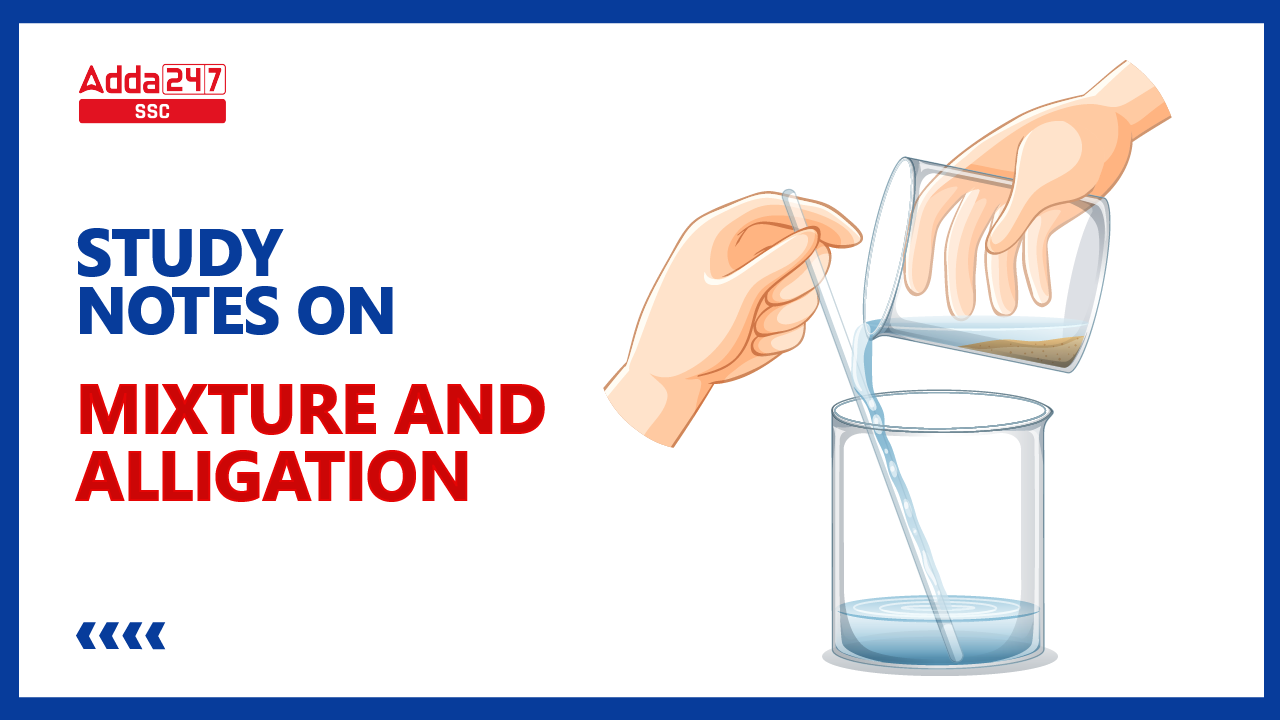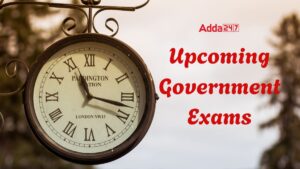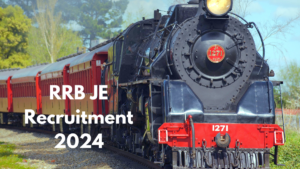Mixture and Alligation is a mathematical technique used to solve problems related to mixing different ingredients or components in different proportions to get a desired mixture with a specific property, such as concentration or price. The rule of Alligation helps us find the right ratio in which two or more ingredients at given prices should be mixed to get a mixture with the desired price.
This topic is crucial because it tests the candidate’s ability to understand and apply mathematical principles to real-life situations involving the mixing of different substances or components. By mastering the rule of mixtures and alligations, aspirants can improve their problem-solving skills and perform better in the quantitative aptitude section of these competitive exams.
In simple terms, the rule of mixtures and alligations is about figuring out the right way to mix different things in the right proportions to get the desired result. This is an important skill to have for government recruitment exams.
Important Terms related to Mixture and Alligations
Mixture: An aggregate of two or more two types of quantities gives us a mixture.
Alligation: It is a method of solving arithmetic problems related to mixtures of ingredients. This rule enables us to find the ratio in which two or more ingredients at the given price must be mixed to produce a mixture of the desired price.
Here are some important terms related to the topic of mixture and alligations:
Mixture: A combination of two or more ingredients or components in a specific ratio.
Alligation: The mathematical technique used to find the ratio in which two or more ingredients at different prices should be mixed to obtain a mixture of a desired price.
Concentration: The measure of the amount of a substance present in a mixture, usually expressed as a percentage or ratio.
Purity: The degree of freedom from impurities or adulterants in a substance.
Relative Quantity: The proportion or ratio of the different ingredients in a mixture.
Understanding these key terms is essential for effectively solving problems related to mixture and alligations in quantitative aptitude sections of competitive exams.

Formula Of Mixture and Alligation
- It is a modified form of finding the weighted average. If 2 ingredients are mixed in a ratio and the cost price of the unit quantity of the mixture, called the Mean Price is given then,
The above formula can be represented with the help of a diagram which is easier to understand. Here ‘d’ is the cost of a dearer ingredient, ‘m’ is the mean price, and ‘c’ is the cost of a cheaper ingredient.
Quantity of Cheaper element /Quantity of Dearer element = CP of 1 unit of dearer element – Mean Price /Mean Price CP of 1 unit of cheaper element

Thus, (Cheaper quantity) : (Dearer quantity) = (d – m) : (m – c).
Questions On Mixture and Alligation
Ques 1. A container contains 40 liters of milk. From this container, 4 liters of milk were taken out and replaced by water. This process was repeated further two times. How much milk is now contained in the container?
Solution: ( B)
Assume that a container contains x of liquid from which y units are taken out and replaced by water. After n operations, the quantity of pure liquid
=x(1-y/x)^n
Hence milk now contained by the container = 40(1-4/40)^3
=40(1-1/10)^3
=40×9/10×9/10×9/10 =(4×9×9×9)/100 =29.16
Solution: (C)
Suppose the vessel initially contains 8 liters of liquid.
Let x liters of this liquid be replaced with water.
Quantity of water in new mixture = (3 – 3x/8 + x) litre
Quantity of syrup in new mixture = (5 – 5x/8) litres
So (3 – 3x/8 + x) = (5 – 5x/8) litres
=> 5x + 24 = 40 – 5x
=>10x = 16
=> x = 8/5 .
So, part of the mixture replaced = (8/5 x 1/8) = 1/5
Suppose the can initially contain 7x and 5x of mixtures A and B respectively.
Quantity of A in mixture left = (7x – 7/12 x 9)litres
= (7x – 21/4) litres.
Quantity of B in mixture left = (5x – 5/12 x 9) litres
= (5x – 15/4) litres.
So (7x – 21/4)/((5x – 15/4) +9) = 7/9
=> (28x – 21)/(20x + 21) = 7/9
=> 252x – 189 = 140x + 147
=> 112x = 336
=> x = 3.
So, they can contain 21 liters
Explanation :
Let the initial quantity of wine = x litre
After a total of 4 operations, quantity of wine = x(1-y/x)^n=x(1-8/x)^4
Given that after a total of 4 operations, the ratio of the quantity of wine left in cask to that of water = 16 : 65
Hence we can write as (x(1-8/x)^4)/x =16/81
(1-8/x)^4 = (2/3)^4
(1-8/x) = 2/3
(x-8/x) = 2/3
3x-24=2x
x=24




 Upcoming Government Exams, Complete Govt...
Upcoming Government Exams, Complete Govt...
 SSC Exam Calendar 2025–26 Out, Check All...
SSC Exam Calendar 2025–26 Out, Check All...
 RRB JE 2024 Notification, CBT 2 Exam Dat...
RRB JE 2024 Notification, CBT 2 Exam Dat...


